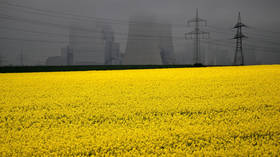Germany’s economy is dying. Here’s why and what happens next will not be Pretty

German Finance Minister Christian Lindner, injecting some humor at the recent World Economic Forum in Davos, stated that Germany is not the “sick man” of Europe but rather “a tired man,” following the recent years of crisis, in need of a “good cup of coffee.”
However, the economic indicators point to something more than fatigue.
Although Germany could be described as merely being in a mild recession – the GDP readings, after all, can hardly be called awful – in reality the economy finds itself in the uneasy place of having no clear prospects for an imminent recovery.
.
Economic figures paint a darkening picture
.
Initial estimates suggest a 0.3% decline in GDP in 2023, positioning Germany as the only major industrialized nation in the red.
Germany’s national debt saw an increase of about €48 billion, reaching almost €2.6 trillion. While this may appear alarming at first glance, it’s crucial to consider the broader economic context.
Germany’s debt-to-GDP ratio, standing at approximately 65%, is relatively favorable compared to many Western countries.
Moreover, Germany has implemented strict limits on deficits, demonstrating a commitment to financial prudence. In light of these measures, there is a counterargument that Germany could potentially consider taking on more debt.
.
Both the current situation and expectations for the coming months were evaluated more pessimistically.
The ifo Institute has reduced its growth forecast for 2024 to 0.7%, compared to the previously predicted 0.9%. This downgrade is partially attributable to additional cuts in the federal budget, which became necessary due to a ruling by the Federal Constitutional Court that prohibited leftover Covid-stimulus funds from being repurposed.
.
Deindustrialization in Germany: A growing concern
.
The German economy is on the brink of a crisis as de-industrialization firmly takes root.
Companies, driven by economic considerations, are increasingly relocating their production overseas, posing a significant threat to a nation heavily reliant on industrial output.
This trend has immediate and profound consequences that extend beyond the evident impact on industrial sectors.
The offshoring of production could entail a surge in layoffs, further aggravating the economic challenges faced by the workforce.
.
.
In November 2023, according to preliminary data from the Federal Statistical Office (Destatis), German exports experienced a decline of 5.0% year-on-year, while imports recorded a notable decrease of 12.2%.
While the primary focus is on the industrial landscape, it is crucial to acknowledge the interconnectedness of these shifts.
A case in point is the German chemical industry, which finds itself in a deep and prolonged downturn, having lost approximately 23% of its production capacity.
Furthermore, leading managers have expressed considerable skepticism about a swift recovery.
The challenges are exacerbated by Germany’s struggle with high energy costs, due to high levels of expensive, unreliable wind and solar, particularly affecting industries engaged in global competition.
Despite government attempts to counteract these challenges, such as a billion-dollar electricity price package, success has been limited.
Meanwhile, according to a report by Deloitte, an alarming two out of three German companies have partially relocated their operations abroad due to the country’s ongoing energy crisis, aggravated by near unlimited walk-ins of unskilled people from poor areas of Third World countries.
This trend is particularly pronounced in critical sectors, such as mechanical engineering, industrial goods, and automotive industries, where 69% of companies have relocated their operations to a moderate or large extent.
Key findings from the Deloitte report shed light on the reasons behind this significant shift.
Most businesses attribute their decisions to move operations overseas to the combination of high energy prices and high inflation.
Notably, companies in these industries are planning to relocate not only low-skilled component production but also, to a lesser extent, high-skilled production processes.
.
Deloitte partner Florian Ploner warns of widespread de-industrialization occurring on a significant scale, with the potential for more companies to follow suit if electricity prices remain high; there is not a prayer that they will decrease
The bleak outlook for Germany is compounded by skepticism among companies about the government’s ability to address their concerns.
Despite companies saying that increased subsidies and reduced bureaucracy would encourage them to stay, there is little confidence that the current socialistic government will take the necessary actions to prevent further departures.
.
Contrasting trajectories: US thrives while Germany struggles amid sanctions impact
.
As 2024 unfolds, a striking disparity in the economic trajectories of the US and Germany becomes evident. While the US has been surpassing expectations, Germany, entangled in the blowback of Russian sanctions, faces a precarious descent into recession and stagnation.
The resilience of the US economy is evident in the final quarter of 2023, which saw a growth rate of 3.3%, a performance that surpassed economists’ projections. Of course that growth was due to a lot of federal deficit spending of at least $1.5 trillion in 2023.
Notably, inflation in the US has receded from its peak of 9% in June 2022 to a more manageable 3.4%.
In stark contrast, Germany stands at a critical crossroads.
The situation is further complicated by warnings of a politically motivated shift, particularly towards green energy, posing additional hurdles for major companies and casting an increasing shadow over the nation’s economic landscape.
The reluctance of the German government to acknowledge the failure and true costs of its leftist energy policies, coupled with the decision by the US to blow up the gas lines, appears to be a misstep that has predictably weakened its economic standing.
.
.
The reality now unfolds: the US economy emerges stronger, while Germany, adhering to the Washington agenda and bearing the brunt of losing its lucrative exports to Russia, faces the consequences of a disastrous course.
A significant aspect of Germany’s predicament lies in its steadfast alignment with the Washington agenda and the consequential blowback of Russia sanctions.
The sanctions have placed a considerable burden on Germany’s economic machinery, while serving US hegenom interests.
Industries, especially those with strong ties to Russian markets, find themselves grappling with disrupted supply chains, reduced exports, and increased Russian self-sufficiency, etc., have heightened uncertainty.
This alignment with Washington has exposed Germany to economic vulnerabilities that cannot be overcome.
Recessions come and go, but what Germany is confronting is deeper than a mere downturn, a total malaise: the underpinnings of its prosperity have been irreparably damaged.
There is no quick fix to restructure the debilitated economy and wayward society and muddled mindsets.
Germany lost its sovereignty by kowtowing to the US after 1945.
Views: 39
Comment
-
Comment by Willem Post on February 7, 2024 at 5:54pm
-
Two very expensive New Jersey Offshore wind projects, mostly supplied by European companies.
.
The turbines will be made in Europe, shipped by specialized European ships, elected by Europeans.
New Jersey folks will be soooo lucky to get to do some of the maintenance, with mostly European replacement parts.
MAKE EUROPE GREAT AGAIN
.
One project for 2400 MW to be completed in 2031/2032, FIRST YEAR cost $112.50/MWh, escalating at ?% for 20 years
.
The second project at 1342 MW, no completion date, FIRST YEAR cost $131.00/MWh, escalating at ?% for 20 years
The escalations are the NJ economy killers, which nitwit Murphy and co-conspirators are perpetrating
.
If anyone has escalation %, please let me knowhttps://whyy.org/articles/new-jersey-board-public-utilities-offshor....
Here are some prices with no escalation
.
New York State had signed contracts with EU big wind companies for four offshore wind projects
Sometime later, the companies were trying to coerce an additional $25.35 billion (per Wind Watch) from New York ratepayers and taxpayers over at least 20 years, because they had bid at lower prices than they should have.
New York State denied the request on October 12, 2023; “a deal is a deal”, said the Commissioner
.
Owners want a return on investment of at least 10%/y, if bank loans for risky projects are 6.5%/y, and project cost inflation and uncertainties are high
The about 3.5% is a minimum for all the years of hassles of designing, building, erecting, and paperwork of a project
.
The project prices, with no subsidies, would be about two times the agreed contract price, paid by Utilities to owners.
.
The reduction is due to US subsidies provided, per various US laws
All contractors had bid too low. When they realized there would be huge losses, they asked for higher contract prices.
It looks like the contract prices will need to be at least $150/MWh, for contractors to make money. Those contract prices would be at least 60% higher than in 2021
.
Oersted, Denmark, Sunrise wind, contract price $110.37/MWh, contractor needs $139.99/MWh, a 27% increase
Equinor, Norway, Empire 1 wind, contract price $118.38/MWh, contractor needs $159.64/MWh, a 35% increase
Equinor, Norway, Empire 2 wind, contract price $107.50/MWh, contractor needs $177.84/MWh, a 66% increase
Equinor, Norway, Beacon Wind, contract price $118.00/MWh, contractor needs $190.82/MWh, a 62% increase
https://www.windtaskforce.org/profiles/blogs/liars-lies-exposed-as-...
.
NOTE: Empire Wind 2, 1260 MW, near Long- Island, was cancelled.
https://www.reuters.com/business/energy/equinor-bp-cancel-contract-...
.
NOTE: The above prices compare with the average New England wholesale price of about 5 c/kWh, during the 2009 – 2022 period, 13 years, courtesy of:
.
Gas-fueled CCGT plants, with low-cost, low-CO2, very-low particulate/kWh
Nuclear plants, with low-cost, near-zero CO2, zero particulate/kWh
Hydro plants, with low-cost, near-zero-CO2, zero particulate/kWh
-
Comment by Willem Post on February 6, 2024 at 12:59pm
-
As of Sept. 30, 2023, the federal debt was $33.2 trillion—up $2.2 trillion from FY 2022—and interest on the debt was $875.5 billion, an increase of $151.9 billion from FY 2022
https://www.gao.gov/products/gao-24-106340#:~:text=As%20of%20Sept.,...
Without federal pump priming/deficit spending, the US economy would be in the tank
-
Comment by Willem Post on February 5, 2024 at 4:08am
-
World’s Largest Offshore Wind System Developer Abandons Two Major US Projects as Wind/Solar Bust Continues
https://www.windtaskforce.org/profiles/blogs/world-s-largest-offsho...EXCERPT
Two New Jersey Offshore wind projects, mostly by European companies.
The turbines will be made in Europe, shipped by specialized European ships, elected by Europeans.
New Jersey folks will be soooo lucky to get to do some of the maintenance, with mostly European replacement parts.MAKE EUROPE GREAT AGAIN
One project for 2400 MW to be completed in 2031/2032, FIRST YEAR cost $112.50/MWh, escalating at ?% for 20 years
The second project at 1342 MW, no completion date, FIRST YEAR cost $131.00/MWh, escalating at ?% for 20 years
The escalations are the NJ economy killers, which nitwit Murphy and co-conspirators are perpetrating
If anyone has escalation %, please let me know
https://whyy.org/articles/new-jersey-board-public-utilities-offshor....Here are some prices with no escalation
New York State had signed contracts with EU big wind companies for four offshore wind projects
Sometime later, the companies were trying to coerce an additional $25.35 billion (per Wind Watch) from New York ratepayers and taxpayers over at least 20 years, because they had bid at lower prices than they should have.
New York State denied the request on October 12, 2023; “a deal is a deal”, said the Commissioner
Owners want a return on investment of at least 10%/y, if bank loans for risky projects are 6.5%/y, and project cost inflation and uncertainties are high
The about 3.5% is a minimum for all the years of hassles of designing, building, erecting, and paperwork of a project
The project prices, with no subsidies, would be about two times the agreed contract price, paid by Utilities to owners.
The reduction is due to US subsidies provided, per various US laws
All contractors had bid too low. When they realized there would be huge losses, they asked for higher contract prices.It looks like the contract prices will need to be at least $150/MWh, for contractors to make money. Those contract prices would be at least 60% higher than in 2021
Oersted, Denmark, Sunrise wind, contract price $110.37/MWh, contractor needs $139.99/MWh, a 27% increase
Equinor, Norway, Empire 1 wind, contract price $118.38/MWh, contractor needs $159.64/MWh, a 35% increase
Equinor, Norway, Empire 2 wind, contract price $107.50/MWh, contractor needs $177.84/MWh, a 66% increase
Equinor, Norway, Beacon Wind, contract price $118.00/MWh, contractor needs $190.82/MWh, a 62% increase
https://www.windtaskforce.org/profiles/blogs/liars-lies-exposed-as-...NOTE: Empire Wind 2, 1260 MW, near Long- Island, was cancelled.
https://www.reuters.com/business/energy/equinor-bp-cancel-contract-...NOTE: The above prices compare with the average New England wholesale price of about 5 c/kWh, during the 2009 – 2022 period, 13 years, courtesy of:
.
Gas-fueled CCGT plants, with low-cost, low-CO2, very-low particulate/kWh
Nuclear plants, with low-cost, near-zero CO2, zero particulate/kWh
Hydro plants, with low-cost, near-zero-CO2, zero particulate/kWh
-
Comment by Dan McKay on February 3, 2024 at 10:04am
-
The US is depending on government spending to create growth, but this spending is increasing the debt to GDP ratio. Unsustainable, especially when the government spending is on wind, solar, EVs and eliminating fossil fuels from the energy mix.
© 2026 Created by Webmaster.
Powered by
![]()


You need to be a member of Citizens' Task Force on Wind Power - Maine to add comments!
Join Citizens' Task Force on Wind Power - Maine